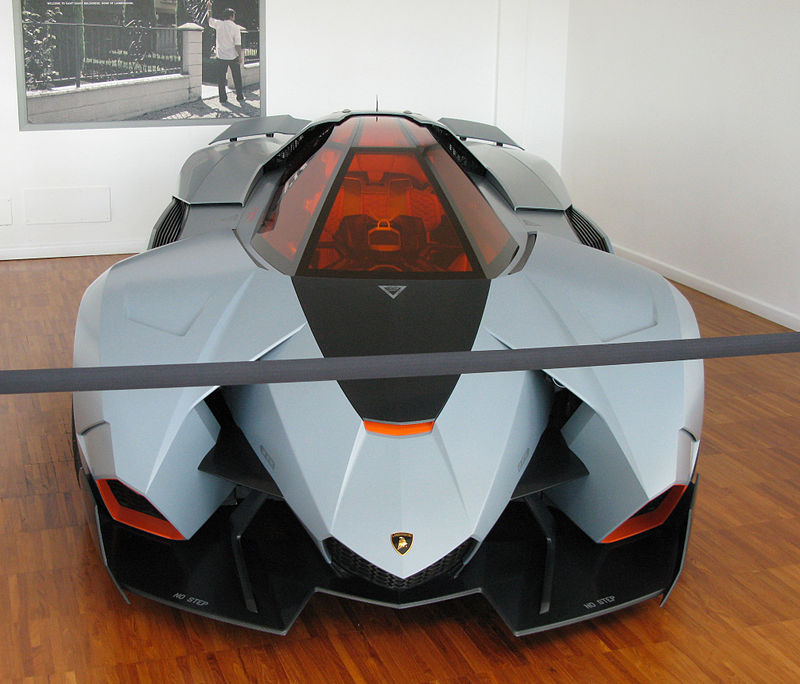Lamborghini Concept S
The Lamborghini Concept S is a 2005 concept car Based on the Lamborghini Gallardo, with an open roadster body designed by Luc Donckerwolke. It was first shown at the 2005 Geneva Motor Show. It was intended to be a modern interpretation of the single-seat roadsters of the past. Utilizing a 'saute-vent' (French for 'change wind') instead of a traditional windscreen, and dividing the interior into two distinct compartments by continuing the bodywork between the seats, which also serves as an air inlet feeding the mid-mounted 5 L V10 engine, gives the car a distinctly futuristic look. This is also to increase aerodynamic flow. The rear-view mirror is even electronically retractable to allow the driver to see behind, when necessary, or hide it when not in use. Though considered more of a styling exercise than a working production vehicle, the final working show car only had to be modified slightly from the original computer-aided designs. Lamborghini had rumored to be building 100 for customers, but decided to keep it as a styling exercise. Only 2 models were ever made: the high-window prototype sits in the Lamborghini museum with no engine, while the running low-window prototype featured at Pebble Beach was up for auction on 10 December 2015 at RM Sotheby's Manhattan event "Driven by Disruption". It was expected to go for $2.4 to 3 million, but failed to sell.
Lamborghini Egoista
The Lamborghini Egoista is a concept car unveiled by Lamborghini for the company's 50th anniversary. The fully functioning model is based on the Gallardo. It features a 5.2 L (317 cu in) V10 engine producing 600 hp (447 kW; 608 PS).
The Lamborghini Egoista has a unique one-seat cockpit, which is similar to that of a modern fighter jet, and has a canopy door that is completely removable. The steering wheel must be removed to enter and exit the vehicle like a Formula One car.
The unique exterior of the Lamborghini Egoista is meant to resemble a bull ready to charge if looked at from the side. The lighting resembles that of a modern airplane, with sidemarkers and indicators on the sides and top of the car as well as front and rear. The bodywork consists of active aerodynamic panels that raise and lower for optimum downforce and stability. The body and wheels are made of antiradar material to even more identify with fighter jets.
In Italian, Egoista literally means "selfish". According to the model's designer Walter de Silva, the Egoista "represents hedonism taken to the extreme.".
The car is now on display at the Lamborghini museum located in Sant'Agata Bolognese.
Lamborghini Estoque
The Lamborghini Estoque (Spanish pronunciation: [esˈtoke]) is a one-off Concept Car built by Lamborghini. Unlike current production Lamborghini cars, which are mid-engine, two-seater sports cars, the Estoque is a four-door sedan.
The Estoque was introduced at the 2008 Paris Motor Show. The Estoque is the first front-engine vehicle by Lamborghini since the LM002 utility vehicle. It is described as a "concept for a $230,000 four-door sedan". It currently houses a 5.2 litre V10 engine, although there has been speculation that this could be replaced by a V12, V8, or possibly even a hybrid or turbo-diesel engine, as suggested by Lamborghini's Brand Director, Manfred Fitzgerald.
As with other Lamborghinis, the Estoque derives its name from the sport and tradition of bullfighting: An estoque is a type of sword traditionally used by matadors.
Lamborghini Flying Star II
The Lamborghini Flying Star II (also named Lamborghini 400 GT Flying Star II) was a prototype concept car built by Carrozzeria Touring in 1966 on a Lamborghini front engine chassis.
In 1966, Carrozzeria Touring Superleggera of Milan explored a new, and for those days very modern design concept. Their long relation with Lamborghini was celebrated with the unique Flying Star II, a fully functional prototype with surprising proportions. The car referred to the famous Touring Flying Stars of the prewar period; a.o. on Alfa Romeo, Lancia and Isotta Fraschini. It had an aluminum V12 engine, 5 speed transmission, fully independent suspension and disc brakes all around. The new design was for a strict two-seater with a very low and compact two-volume bodywork. It represented the ultimate machine for 2 people to travel fast in style and with luggage. This would be the last design to come out of Carrozzeria Touring Superleggera, before the company was revived in 2006 and introduced the A8GCS Berlinetta Touring based on a Maserati drivetrain in 2008.
Lamborghini Marzal
The Lamborghini Marzal is a concept car, first presented by Lamborghini at the 1967 Geneva Motor Show.
Designed by Marcello Gandini of Bertone, it was created to supply Ferruccio Lamborghini with a true four-seater car for his lineup which already included the 400GT 2+2 and the Miura. It was distinguished by amply glazed gullwing-doors and an equally amply louvered rear window. Propulsion was by a 2L 175 bhp (130 kW) in-line six engine, actually a split-in-half version of Lamborghini's 4L V12, mated to a five speed transmission.
The Marzal remained a one-off, though the general shape and many of the ideas would later be used in the Lamborghini Espada. The Marzal design probably found wider recognition as a die-cast model, with both Dinky Toys and Matchbox making scale models, albeit in other colours such as orange, despite the original show car being painted silver. This car was publicly driven only once, by Princess Grace and her husband, as the Monaco Grand Prix pace car the same year it was designed.
The Marzal made a second public appearance at the 1996 Concours Italiano in Monterey, California in honor of Carrozzeria Bertone. The Lamborghini Athon was also exhibited at this time. The Marzal was located for a long time in the Bertone Design Study Museum, and it was sold in auction at Villa d'Este (Italy) on 21 May 2011, for the highest bid of 1,350,000 Euros, approximately 2 million dollars.


.jpg/800px-Lamborghini_Gallardo_LP-560-4_Spyder_(5482252151).jpg)









.jfif)




No comments:
Post a Comment